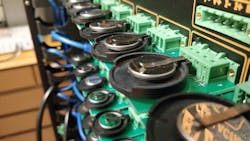A Layer of Tellurium Boosts Lithium-ion’s Operational Life
A research team at The University of Texas at Austin has found a way to stabilize lithium-sulfur batteries, making them more likely to become commercially viable. The researchers added a layer of tellurium on top of the lithium metal inside the battery and found it extends the battery’s lifespan by a factor of four compared to other lithium batteries.
Engineers had long been trying to improve lithium-sulfur batteries because they deliver more use per charge and are environmentally friendlier, but degrade quickly over time. Both the positive and negative electrodes in lithium-sulfur batteries hold 10 times as much charge capacity as materials in today’s lithium-ion batteries, according to says Arumugam Manthiram, a mechanical engineering professor at UT.
Lithium is a reactive element that tends to break down other elements around it. Every cycle of a lithium-sulfur battery, the process of charging and discharging it, creates needle-like deposits to form on the lithium-metal anode, the negative electrode of the battery. The deposits break down the electrolyte that shuttles lithium ions back and forth. This traps some lithium, keeping the electrode from delivering the power for long use. The deposits are also responsible for short-circuiting many lithium batteries and causing them to catch fire.
The tellurium coating on the lithium electrode protects the electrolyte from degrading, stunts the growth of deposits and lets the battery last longer. The same type of layer can be used on other lithium and lithium-sodium batteries.
Manthiram explains that lithium-sulfur batteries are currently best suited for devices that need lightweight batteries and need to run for a long time on a single charge but don’t require a large number of charge cycles, such as drones. But the new versions could extend the range of electric vehicles and be used to store energy from wind, solar and other renewable options.
Sulfur is abundant and widely available as a byproduct from the oil and gas industry, and there are no supply-chain issues, making the batteries inexpensive to produce. It is also more environmentally friendly than metal oxides used in lithium-ion batteries.

